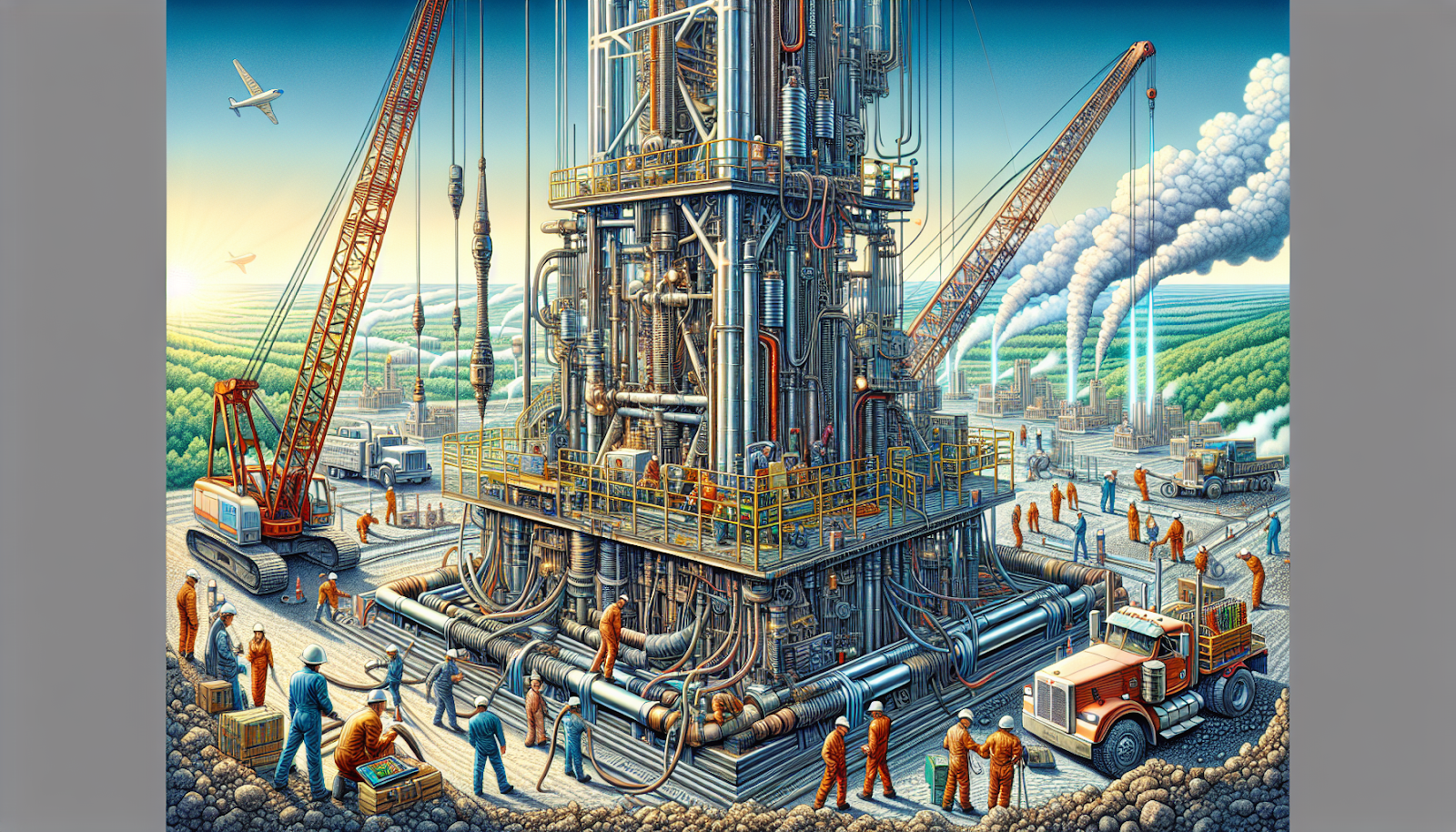Introduction to Geothermal Drilling
Geothermal drilling is a crucial process in harnessing the Earth’s internal heat for sustainable energy production. This article delves into the various techniques and technologies employed in geothermal drilling, highlighting their advantages, challenges, and future prospects.
Types of Geothermal Drilling
There are two primary types of geothermal drilling:
- Conventional Rotary Drilling
- Percussion Drilling
Conventional Rotary Drilling
Conventional rotary drilling is the most common method used in geothermal drilling. It involves the use of a rotating drill bit attached to a drill pipe, which gradually grinds through the rock formations to reach the desired depth.
Advantages of Conventional Rotary Drilling
- Suitable for a wide range of rock types
- Achieves greater depths compared to percussion drilling
- Allows for the collection of rock samples during drilling
Challenges of Conventional Rotary Drilling
- Slower drilling rates in hard rock formations
- Higher costs associated with drill bit wear and replacement
- Potential for borehole instability in fractured or unconsolidated formations
Percussion Drilling
Percussion drilling, also known as cable tool drilling, relies on the repeated lifting and dropping of a heavy drill bit to crush and pulverise the rock formations.
Advantages of Percussion Drilling
- Effective in hard rock formations
- Lower costs compared to conventional rotary drilling
- Reduced risk of borehole collapse in unstable formations
Challenges of Percussion Drilling
- Limited drilling depth capacity
- Slower drilling rates compared to conventional rotary drilling
- Inability to collect rock samples during drilling
Geothermal Drilling Techniques
Several advanced techniques have been developed to enhance the efficiency and effectiveness of geothermal drilling:
- Directional Drilling
- Underbalanced Drilling
- Managed Pressure Drilling
Directional Drilling
Directional drilling allows for the creation of deviated or horizontal wellbores, enabling access to geothermal resources that are not directly beneath the drilling site.
Applications of Directional Drilling
- Accessing geothermal reservoirs in environmentally sensitive areas
- Drilling multiple wellbores from a single drilling pad
- Intersecting fracture networks for enhanced geothermal fluid circulation
Challenges of Directional Drilling
- Increased complexity and costs compared to vertical drilling
- Potential for wellbore instability in highly deviated sections
- Difficulty in maintaining optimal drill bit orientation and control
Underbalanced Drilling
Underbalanced drilling involves maintaining the wellbore pressure lower than the formation pressure, allowing for improved drilling performance and reduced formation damage.
Benefits of Underbalanced Drilling
- Enhanced drilling rates and reduced drill bit wear
- Minimised formation damage and improved well productivity
- Reduced risk of lost circulation and wellbore instability
Challenges of Underbalanced Drilling
- Increased complexity and costs associated with specialised equipment and personnel
- Potential for uncontrolled fluid influx and well control issues
- Difficulty in maintaining the desired underbalanced condition in deep or high-pressure formations
Managed Pressure Drilling
Managed pressure drilling (MPD) is a technique that precisely controls the wellbore pressure profile to optimise drilling performance and mitigate drilling hazards.
Advantages of Managed Pressure Drilling
- Enhanced well control and reduced risk of kicks and blowouts
- Improved drilling efficiency and reduced non-productive time
- Ability to drill through narrow pressure windows and challenging formations
Challenges of Managed Pressure Drilling
- Higher costs associated with specialised equipment and personnel
- Increased complexity and training requirements for drilling crews
- Potential for equipment failures and maintenance issues
Geothermal Drilling Fluids
Drilling fluids, also known as drilling muds, play a crucial role in geothermal drilling operations. They serve multiple functions, including:
- Cooling and lubricating the drill bit
- Removing drill cuttings from the wellbore
- Maintaining wellbore stability
- Controlling formation pressures
Types of Geothermal Drilling Fluids
- Water-based muds (WBMs)
- Oil-based muds (OBMs)
- Synthetic-based muds (SBMs)
Water-Based Muds (WBMs)
Water-based muds are the most commonly used drilling fluids in geothermal drilling. They are composed of water, clay, and various additives to optimise their properties.
Advantages of Water-Based Muds
- Lower costs compared to oil-based and synthetic-based muds
- Environmentally friendly and easier to dispose of
- Effective in most geothermal drilling scenarios
Challenges of Water-Based Muds
- Reduced performance in high-temperature and high-pressure conditions
- Potential for clay swelling and wellbore instability in reactive formations
- Limited lubricity and increased risk of differential sticking
Oil-Based Muds (OBMs)
Oil-based muds use oil as the continuous phase and provide superior performance in challenging drilling conditions.
Advantages of Oil-Based Muds
- Excellent stability and performance in high-temperature and high-pressure environments
- Enhanced lubricity and reduced risk of differential sticking
- Improved wellbore stability in reactive formations
Challenges of Oil-Based Muds
- Higher costs compared to water-based muds
- Environmental concerns and strict regulations for disposal
- Increased safety risks associated with flammability and toxicity
Synthetic-Based Muds (SBMs)
Synthetic-based muds are formulated using synthetic oils that combine the performance benefits of oil-based muds with improved environmental compatibility.
Advantages of Synthetic-Based Muds
- Similar performance to oil-based muds in challenging drilling conditions
- Reduced environmental impact compared to oil-based muds
- Improved biodegradability and easier disposal
Challenges of Synthetic-Based Muds
- Higher costs compared to water-based muds
- Potential for contamination and decreased performance if not properly maintained
- Regulatory requirements and environmental considerations for disposal
Geothermal Drilling Innovations
The geothermal drilling industry continuously seeks innovations to improve drilling efficiency, reduce costs, and overcome technical challenges. Some notable innovations include:
- Advanced Drill Bit Designs
- Automated Drilling Systems
- High-Temperature Electronics and Sensors
Advanced Drill Bit Designs
Specialised drill bit designs have been developed to enhance drilling performance in geothermal environments. These include:
- Polycrystalline Diamond Compact (PDC) bits
- Thermally stable polycrystalline (TSP) diamond bits
- Hybrid drill bits combining PDC and roller cone technologies
Automated Drilling Systems
Automated drilling systems utilise advanced algorithms, real-time data analysis, and machine learning techniques to optimise drilling parameters and improve overall drilling efficiency.
Benefits of Automated Drilling Systems
- Consistent and optimised drilling performance
- Reduced human error and increased safety
- Continuous monitoring and adjustment of drilling parameters
Challenges of Automated Drilling Systems
- High initial costs for implementation and integration
- Need for specialised training and skilled personnel
- Potential for system failures and downtime
High-Temperature Electronics and Sensors
The development of high-temperature electronics and sensors has been crucial for geothermal drilling, enabling real-time monitoring and data acquisition in extreme downhole conditions.
Applications of High-Temperature Electronics and Sensors
- Logging-while-drilling (LWD) tools for real-time formation evaluation
- Measurement-while-drilling (MWD) tools for directional drilling and wellbore positioning
- Downhole monitoring systems for pressure, temperature, and fluid properties
Challenges of High-Temperature Electronics and Sensors
- Limited operating temperatures and reliability in extreme geothermal conditions
- High development and manufacturing costs
- Potential for failure and data loss in harsh downhole environments
Environmental Considerations in Geothermal Drilling
Geothermal drilling operations must prioritise environmental sustainability and minimise their impact on the surrounding ecosystem. Key environmental considerations include:
- Emissions Reduction
- Water Resource Management
- Noise and Visual Impact Mitigation
Emissions Reduction
Geothermal drilling operations aim to reduce greenhouse gas emissions and improve air quality through the following measures:
- Utilising clean-burning fuels and advanced emission control technologies
- Implementing energy-efficient drilling practices and equipment
- Adopting carbon capture and storage (CCS) technologies
Water Resource Management
Efficient water management is crucial in geothermal drilling to minimise freshwater consumption and protect local water resources. Strategies include:
- Implementing closed-loop drilling fluid systems to reduce water consumption
- Treating and reusing produced water for drilling operations
- Proper disposal and containment of drilling fluids and waste
Noise and Visual Impact Mitigation
Geothermal drilling sites can have noise and visual impacts on the surrounding communities and wildlife. Mitigation measures include:
- Utilising noise suppression equipment and barriers
- Scheduling drilling activities to minimise disturbance
- Implementing visual screening and landscaping techniques
Future Prospects of Geothermal Drilling
The future of geothermal drilling equipment is promising, with ongoing research and development focused on the following areas:
- Enhanced Geothermal Systems (EGS)
- Supercritical Geothermal Resources
- Advanced Drilling Technologies
Enhanced Geothermal Systems (EGS)
Enhanced Geothermal Systems involve creating artificial geothermal reservoirs in hot dry rock formations by fracturing the rock and circulating fluids through the created fracture network.
Advantages of Enhanced Geothermal Systems
- Potential to access vast geothermal resources in non-conventional settings
- Increased geographical flexibility for geothermal power generation
- Reduced reliance on naturally occurring hydrothermal systems
Challenges of Enhanced Geothermal Systems
- High costs associated with reservoir creation and stimulation
- Technical complexities in controlling and maintaining the fracture network
- Potential for induced seismicity and public acceptance concerns
Supercritical Geothermal Resources
Supercritical geothermal resources refer to high-temperature and high-pressure fluids that exist in a supercritical state, offering higher energy content and power generation potential.
Benefits of Supercritical Geothermal Resources
- Significantly higher power output per well compared to conventional geothermal resources
- Reduced environmental footprint and land use requirements
- Potential for enhanced efficiency in power generation and direct use applications
Challenges of Supercritical Geothermal Resources
- Extreme downhole conditions requiring advanced drilling and completion technologies
- Increased risks associated with well control and safety
- Limited understanding of supercritical reservoir behaviour and long-term sustainability
Advanced Drilling Technologies
The development of advanced drilling technologies aims to overcome the technical and economic barriers associated with geothermal drilling. These include:
- Laser drilling and rock spallation techniques
- Plasma drilling and arc heating technologies
- Microwave-assisted drilling and rock weakening methods
Potential Benefits of Advanced Drilling Technologies
- Increased drilling rates and reduced drilling costs
- Ability to drill through hard and abrasive rock formations
- Reduced wear and tear on drilling equipment
Challenges of Advanced Drilling Technologies
- High research and development costs
- Scalability and reliability concerns for field applications
- Integration with existing drilling infrastructure and practices
Conclusion
Geothermal drilling plays a vital role in unlocking the vast potential of geothermal energy resources worldwide. With the advancement of drilling techniques, technologies, and environmental stewardship, the geothermal industry is poised for significant growth and contribution to the global sustainable energy mix. Continued research, innovation, and collaboration among stakeholders will be essential in overcoming the challenges and realising the full potential of geothermal drilling in the years to come.




